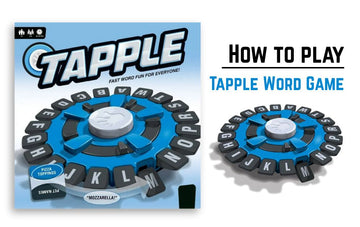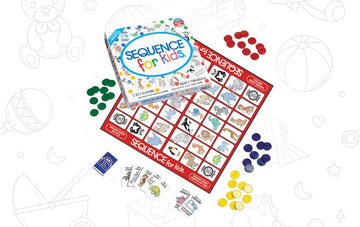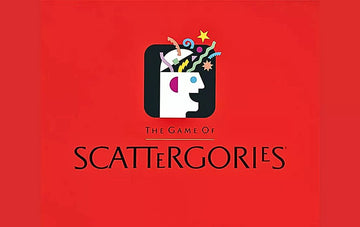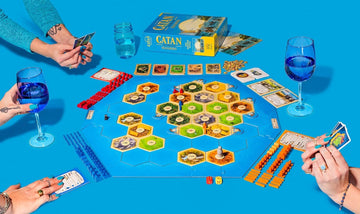How to Play Series
How To Play - Azul
by Mithu Mondal
on
May 17, 2024
Introduction
Welcome to the world of Azul, a captivating tile-placement game inspired by the intricate beauty of Portuguese azulejos. Whether you're a seasoned board gamer or new to the hobby, Azul offers a blend of strategy, aesthetics, and engaging gameplay that’s sure to delight. This guide will walk you through the essentials of how to play, ensuring you're ready to dive into your first game with confidence.
-
Player Count: 2–4
-
Age Range: 8 and up
-
Objective: Collect and place tiles on your player board to create patterns and score the most points.
Set Up

1. Take a personal player board and a scoring cube.
Each player board in Azul has a score track on top, a set of empty spaces on the left, and a 5 x 5 grid called a “wall” on the right. Take a player board and set it in front of you so the multicolored wall is face-up. Place a black scoring cube in the 0 slot of the score track
For a more advanced and strategic game, use the side of the player board with the gray wall instead.
2. Set the Factory displays and starting tile in the center of the table.
The Factory displays are the circular cardboard pieces in the box, and the starting tile is white with the number “1” printed on it. Arrange the Factory displays in a circle in the middle of the table and set the starting tile in the center. The number of factory displays in your game depends on how many players you have.
-
2 players: 5 Factory displays
-
3 players: 7 Factory displays
-
4 players: 9 Factory displays
3. Place 4 colored tiles from the bag onto each Factory display.
Put all 100 tiles in the fabric bag and give them a good mix. For each Factory display, draw 4 tiles at random and set them on top. These tiles are the ones available for the current round. Now you’re ready to start the game.
- There are 20 tiles in each of the 5 colors.
- Keep the bag and game box within reach because you’ll use them again at the end of the round.
Playing A Round

1. Take tiles of 1 color from 1 Factory display or the middle of the table.
According to the game rules, the last player who visited Portugal takes the first turn. Otherwise, choose a player at random. On your turn, you may choose any one of the Factory displays to take tiles from, but you may only take all the tiles of a single color. Alternatively, if there are tiles in the center of the Factory displays on a later turn, you may choose to take all the pieces of a single color from there as well.
- This is called the “Factory offer” phase.
- If you’re the first person to take tiles from the middle of the table, take the starting tile as well and place it into the leftmost slot of the “floor line” at the bottom of your board. Picking this tile lets you go first during the next round.
-
Strategy Tip: Pay attention to how many open spaces you have available on each of your pattern lines. Try to pick from Factory displays that have enough tiles to fill up the available spaces in a single line.

2. Add the chosen tiles to a pattern line on the left side of your board.
When you select the tiles, choose one of the 5 pattern lines that have between 1 and 5 open spaces on the left side of your board. Set the tiles you took from the Factory display or center of the table into the spaces on the pattern line from right to left.
- If you took more tiles than the available spaces in the pattern row, put the extra tiles into the spaces of the floor line at the bottom of your board from left to right. The tiles in the floor line are worth negative points at the end of the round, so be careful to only take as many tiles as you need for the pattern lines.
- Even if you can place the chosen tiles in a pattern line, you may choose to place the tiles in the floor line instead.
- If it’s a later turn and you already have tiles in a pattern row, you may not add tiles of a different color to the same row. So if you have 2 dark blue tiles in the third pattern row, you may only play an additional dark blue tile there on a later turn.

3. Move unchosen tiles to the center of the table.
If there are any leftover pieces on the Factory display you took tiles from, place them in the center of the table next to the starting tile. These tiles are now available to take on a later turn.
4. Take turns choosing tiles until they’ve all been taken.
After you take your turn, the player to your left takes the next turn. Continue choosing a single color from a display or the middle of the table and placing the tiles on their board until there aren’t any tiles left available.
- If you don’t have room for your tiles on any of your pattern lines because you already started lines of a different color or because the spaces are filled, immediately place the tiles in your floor line.
-
Strategy Tip: Pay attention to what other players are taking and what they have on their board. Try to take tiles that they need to complete pattern lines so they have fewer options to pick from.

5. Move 1 tile from a completed pattern line to the wall’s matching space.
Once all the tiles are gone, all players can do the next steps simultaneously. Check the pattern lines on your board, starting from the top and moving toward the bottom. If you filled all the spaces in a pattern line with matching tiles, take the rightmost tile and place it onto the unfilled matching colored space of the wall on the right side of your board. Take the remaining tiles of the completed pattern line (that is now missing the rightmost tile) and empty them into the game box.
- Every time you move a tile from a pattern line to the wall, score points.
- If the matching colored space of the wall is already filled, all tiles from the completed pattern line must be moved to the floor line.
- This is called the “Wall-tiling” phase.

6. Leave tiles of uncompleted pattern lines on your board.
If you weren’t able to fill all the spaces in a pattern line, keep all the tiles in that line for the next round. That way, you’ll be able to collect the remaining tiles you need to complete the line.
- Try to fill the pattern lines on your board each round because you won’t have as much space to collect tiles during the following round.

7. Refill the Factory displays with 4 tiles and start the next round.
Whoever took the starting tile during the last round gets to start the following round. Set the starting tile back in the center of the table and draw 4 new tiles for each of the Factory displays. Continue playing rounds until someone triggers the end of the game.
- If you ever run out of tiles in the bag, refill it with any tiles you put into the game box.
Scoring

1. Score 1 point for placing a tile on your wall without adjacent tiles.
When you move a tile from the pattern line to the wall, and there aren’t any other tiles directly above, below, or to the left or right, then immediately gain 1 point. Move your scoring cube up 1 space on your player board’s track.
- For the first tile you move to your wall, you’ll always score 1 point.

2. Earn points for tiles linked vertically or horizontally to one you placed.
When you place the tile into your wall, check if there are any tiles immediately above, below, to the left, or to the right. If there are, count the number of tiles that are touching each other in the horizontal row. Then, count the number of tiles that connect in the same vertical column as the one you just placed. Move the total points you earned on the score track immediately after placing the tile.
-
Example: If there are 2 adjacent tiles in a horizontal row and you place a third one next to it, you earn 3 points for it.
-
Example: If the tile you placed has 1 tile adjacent above it and 1 tile adjacent to the left, you earn a total of 4 points (2 points for the linked tiles in the row, and 2 points for the linked tiles in the column).

3. Lose points for each tile in the floor line at the end of the round.
If you added any tiles to your floor line, look for the negative point value printed over each space. Moving left to right along the floor line, remove the tile from the floor line and move your scoring cube back by the number of spaces listed above it. Put any colored tiles from the floor line into the game box.
- If you fill your floor line during the round, you’ll lose 14 points total.
- The starting tile always goes into your floor line, so taking it always means you’ll lose at least 1 point.

4. Gain end-game points for finishing rows, columns, and colors.
While you won’t score points right away for completing pattern goals, they’ll earn you a big bonus at the end of the game so you’re able to take the lead.
- For every completed horizontal row with 5 tiles, gain 2 points.
- For each complete vertical column with 5 tiles, earn 7 points.
- For each color where you placed 5 tiles on your wall, score 10 points.
Winning The Game

1. End the game after a player finishes 1 horizontal row on their wall.
During each Wall-tiling phase, check if you completed 1 horizontal row by placing all 5 tiles. If no one completes a row, then the game continues to the next round. Once you or another player completes a row, finish placing tiles and move on to end-game scoring.
- The shortest game of Azul will be 5 rounds, but it usually takes longer so players can earn additional points.
-
Strategy Tip: Try to complete a column or two before finishing a horizontal line so you can earn extra points.

2. Win the game if you earned the most points from placing your tiles.
You’ll have the points you earned from the game’s round already marked with the scoring cube on your player board. Just add any points from completed rows, columns, and colors to calculate your final score. Whoever has the most points, wins!
- If there’s a tie for first place, whoever completed the most horizontal rows of their wall wins. If there’s still a tie, then the game is a draw.
- Tiles left over on the pattern lines don’t count for additional points.
Conclusion
Azul is more than just a game; it’s a journey into the art of strategic thinking and visual delight. By understanding the rules and employing a few strategic tips, you'll be well on your way to mastering this elegant game. So gather your friends or family, lay out the tiles, and let the vibrant patterns and competitive fun of Azul transform your game night into a memorable experience. Enjoy creating your mosaic masterpiece.





















